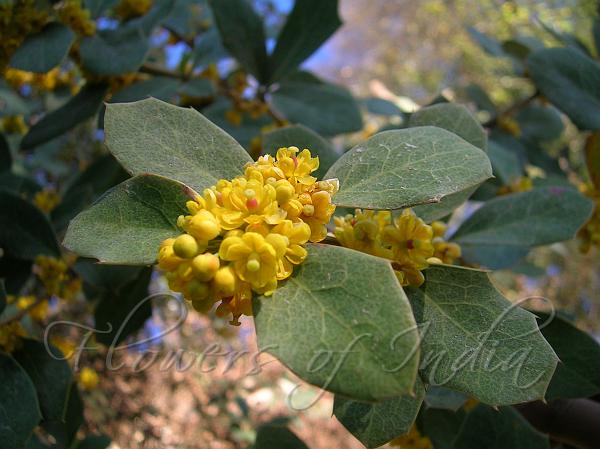|
| Asian Barberry |
|

|

| File size | 649484 |
| Original date | 2/28/06 8:53 AM |
| Resolution | 2048 x 1536 |
| Flash | Flash did not fire, auto |
| Focal length | 5.7mm |
| Exposure time | 1/235s |
| Aperture | 2.8 |
| Focus Distance | |
| Metering Mode | Partial |
| Camera make | NIKON |
| Camera model | E3700 |
| Sensor type |
|
|
|
|
Photo: |
Botanical name: Berberis asiatica Family: Berberidaceae (Barberry family)
Synonyms: Berberis hypoleuca, Berberis asiatica var. clarkeana
Synonyms: Berberis hypoleuca, Berberis asiatica var. clarkeana
Asian Barberry is a much branched shrub 2-4 rn,
with pale yellow branches, and thick rigid evergreen leaves with
usually 2-5 spiny teeth, shining dark grcen above and greyish beneath.
Flowers pale yellow, in somewhat flat-topped clusters shorter than the
leaves, with red hairless stalks; petals obovate, notched, 5-7 rnm.
Leaves ovate to elliptic. 1.8-7.5 cm; stem splnes 1- 1.5 cm. Fruit is
glaucous, dark purple, oblong-ovoid, 8 mrn. Fruit edible. Fruit - raw
or dried and used like raisins. This species is said to make the best
Indian raisins. Asian Barberry is found in the Himalayas, from
Uttarakhand to SW China, at altitudes of 1200-2500 m. Flowering:
March-May.
Medicinal uses: The roots are used in treating
ulcers, urethral discharges, ophthalmia, jaundice, fevers etc. The bark
and wood are crushed in Nepal then boiled in water, strained and the
liquid evaporated until a viscous mass is obtained. This is
antibacterial, laxative and tonic. It is taken internally to treat
fevers and is used externally to treat conjuctivitis and other
inflammations of the eyes. Tender leaf buds are chewed and held against
affected teeth for 15 minutes to treat dental caries. The fruit is
cooling and laxative.
The roots are used in treating
ulcers, urethral discharges, ophthalmia, jaundice, fevers etc. The bark
and wood are crushed in Nepal then boiled in water, strained and the
liquid evaporated until a viscous mass is obtained. This is
antibacterial, laxative and tonic. It is taken internally to treat
fevers and is used externally to treat conjuctivitis and other
inflammations of the eyes. Tender leaf buds are chewed and held against
affected teeth for 15 minutes to treat dental caries. The fruit is
cooling and laxative.
Medicinal uses:
 The roots are used in treating
ulcers, urethral discharges, ophthalmia, jaundice, fevers etc. The bark
and wood are crushed in Nepal then boiled in water, strained and the
liquid evaporated until a viscous mass is obtained. This is
antibacterial, laxative and tonic. It is taken internally to treat
fevers and is used externally to treat conjuctivitis and other
inflammations of the eyes. Tender leaf buds are chewed and held against
affected teeth for 15 minutes to treat dental caries. The fruit is
cooling and laxative.
The roots are used in treating
ulcers, urethral discharges, ophthalmia, jaundice, fevers etc. The bark
and wood are crushed in Nepal then boiled in water, strained and the
liquid evaporated until a viscous mass is obtained. This is
antibacterial, laxative and tonic. It is taken internally to treat
fevers and is used externally to treat conjuctivitis and other
inflammations of the eyes. Tender leaf buds are chewed and held against
affected teeth for 15 minutes to treat dental caries. The fruit is
cooling and laxative. | Identification credit: Ishwari Datt Rai | Photographed in Mussoorie & Ranikhet, Uttarakhand. |
• Is this flower misidentified? If yes,